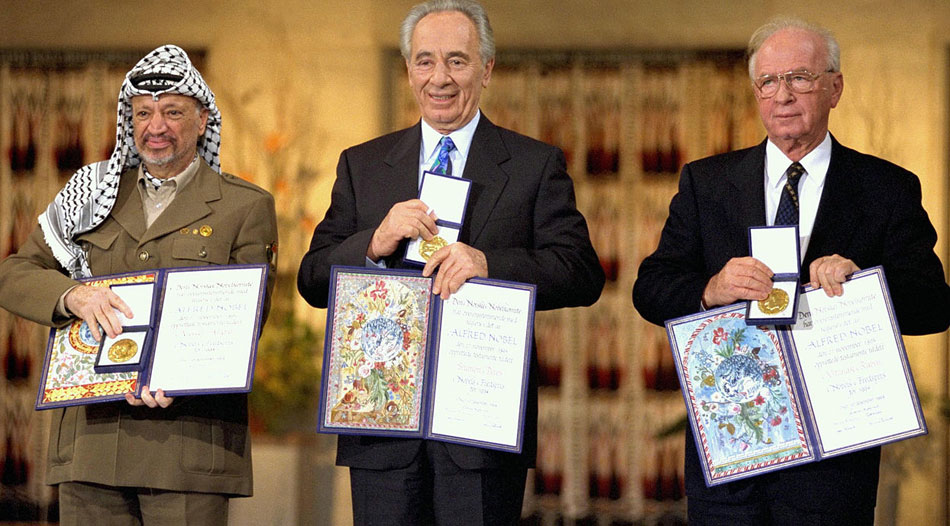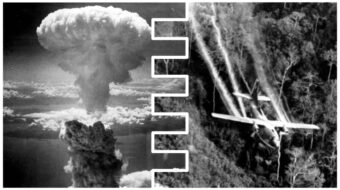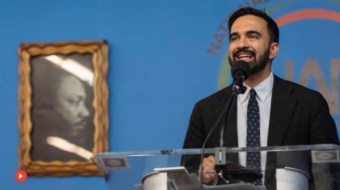
The Oslo I Accord, officially called the Declaration of Principles on Interim Self-Government Arrangements, was an attempt in 1993 to set up a framework that would lead to resolving the ongoing Israeli–Palestinian conflict. It was the first face-to-face agreement between the government of Israel and the Palestine Liberation Organization (PLO).
Negotiations concerning the agreement were conducted secretly in Oslo, Norway, and completed 25 years ago, on August 20, 1993. The Oslo Accord was subsequently officially signed at a public ceremony in Washington, D.C., on September 13, 1993, in the presence of PLO chairman Yasser Arafat, Israeli Prime Minister Yitzhak Rabin and U.S. President Bill Clinton. The documents themselves were signed by Mahmoud Abbas for the PLO, Foreign Minister Shimon Peres for Israel, U.S. Secretary of State Warren Christopher for the U.S., and Foreign Minister Andrei Kozyrev for Russia.
The Accord provided for the creation of a Palestinian interim self-government, the Palestinian National Authority (PNA), which would have responsibility for administering the territory under its control. It also called for the withdrawal of the Israel Defense Forces (IDF) from parts of the Gaza Strip and West Bank.
Israel was to grant Palestinian self-government in phases. In order that the Palestinians govern themselves according to democratic principles, free and general political elections would be held for the Palestinian Council. Jurisdiction of the Council would cover the West Bank and Gaza, except for issues that would be finalized in the permanent status negotiations. Both sides viewed the West Bank and Gaza as a single territorial unit.
It was anticipated that this arrangement would last for a five-year interim period during which a permanent agreement would be negotiated, beginning no later than May 1996. Remaining issues such as Jerusalem, Palestinian refugees, Israeli settlements, security and borders would be part of the “permanent status negotiations” during this time.
In August 1993, the delegations had reached an agreement, which was signed in secrecy by Peres while visiting Oslo. In the Letters of Mutual Recognition, the PLO acknowledged the State of Israel and pledged to reject violence and its desire for the destruction of the Israeli state, and Israel recognized the PLO as the representative of the Palestinian people and as partner in negotiations. Yasser Arafat was allowed to return from exile to the Occupied Palestinian Territories.
In 1995, the Oslo I Accord was followed by Oslo II, but significantly, neither promised Palestinian statehood. The transitional period would lead to a permanent settlement based on UN Security Council Resolutions 242 and 338, an integral part of the whole peace process.
The interim period would begin with Israel’s withdrawal from the Gaza and the Jericho area, marked by the signing of the Gaza–Jericho Agreement on May 4, 1994. Thus the interim period would end on May 4, 1999. Matters transferred from the IDF to Palestinian control concerned education and culture, health, social welfare, direct taxation, and tourism. The Council would establish a strong police force, while Israel would continue to carry the responsibility for defense against external threats.
An Israeli–Palestinian Economic Cooperation Committee would be established in order to develop and implement in a cooperative manner the programs identified in the protocols.
Annexes to the Accord assured safe passage for persons and transportation between the Gaza Strip and Jericho area, and coordination between both parties regarding passages between Gaza and Egypt, and Jericho and Jordan. The two sides also agreed to cooperate in the context of the multilateral peace efforts in promoting a development program for the region, including the West Bank and the Gaza Strip, to be initiated by the G7 countries.
The Interim Agreement on the West Bank and the Gaza Strip (known as Oslo 2), signed in September 1995, gave Palestinians self-rule in Bethlehem, Jenin, Nablus, Qalqilya, Ramallah, Tulkarm, Hebron, and some 450 villages. After 1995, a number of additional agreements were concluded to implement the Oslo Accords. The agreement on Hebron was especially contentious as it created a small, fortified area of its old city where a group of Israeli settler families chose to reside for historical, theological and territorial reasons, surrounded by more than 120,000 Palestinians. The central business district and market area was thus effectively closed off to Palestinians.
Reactions to Oslo
Owing to the broad international acclaim for the accord, hopes for peace lifted hearts and spirits around the globe. The image of the two parties shaking hands on the White House lawn before Pres. Clinton remained an indelibly buoyant blessing on the “peace process.” The following year, Israeli Prime Minister Yitzhak Rabin, Israeli Foreign Minister Shimon Peres, and PLO Chairman Yasser Arafat received the Nobel Peace Prize “for their efforts to create peace in the Middle East.”
In Israel, however, a strong debate over the accords took place: The left supported them, while the right opposed them. After a two-day discussion in the Knesset about the government’s signing the accord, in a vote of confidence, 61 Knesset members voted for the decision, 50 voted against, and 8 abstained. The “peace process” would clearly not proceed smoothly.
Palestinian reactions were also divided. Fatah, the group that represented the Palestinians in the negotiations, accepted the accords. But other groups, such as Hamas, Palestinian Islamic Jihad and the Popular Front for the Liberation of Palestine, objected to them.
On both sides, there were fears of the other side’s intentions. Israelis suspected that the Palestinians were entering into a tactical peace agreement, and that they were not sincere about wanting to reach peace and coexistence with Israel. They saw it as part of the PLO’s Ten Point Program which called for a national authority “over every part of Palestinian territory that is liberated” until “the liberation of all Palestinian territory,” and understood the signing of the accord as a step toward that final goal.
Jerusalem’s new mayor and later Prime Minister Ehud Olmert opposed the agreement and called it a “dark cloud over the city.” He wanted to bring more Jews to settle in historically Palestinian East Jerusalem and expand the city into the Occupied Territories.
Many Palestinians feared that Israel was not serious about dismantling their settlements in the West Bank, especially around Jerusalem. They feared that during the five-year interim period before the conclusion of a final agreement, the Israelis might even accelerate their settlement program by establishing new settlements and greatly expanding existing ones.
The Oslo Accords, which projected a mutually satisfactory resolution to the “peace process,” never resulted in peace, only fitful “process” that time and again, year after year, derailed and delayed the world’s hope.
Given the arc of Zionist hegemonic expansion starting early in the 20th century, even before Israeli statehood, and the express desire on the part of many right-wing Zionists to eventually occupy and control the entire “Eretz Israel,” i.e., the ancient Biblical lands where Jews lived, peace would turn out to be a chimera, a mirage in the desert.
In a 2001 video, Benjamin Netanyahu, reportedly unaware he was being recorded, said: “They asked me before the election if I’d honor [the Oslo accords]…. I said I would, but [that] I’m going to interpret the accords in such a way that would allow me to put an end to this galloping forward to the ’67 borders. How did we do it? Nobody said what defined military zones were. Defined military zones are security zones; as far as I’m concerned, the entire Jordan Valley is a defined military zone. Go argue.”
Netanyahu then explained how he conditioned his signing of the 1997 Hebron agreement on American consent that there be no withdrawals from “specified military locations,” and insisted that he would specify which areas constituted a “military location”—such as the whole of the Jordan Valley. “Why is that important? Because from that moment on I stopped the Oslo Accords,” Netanyahu claimed.
However, this is clearly consistent with Prime Minister Yitzhak Rabin’s October 1995 statement to the Knesset on the ratification of the interim Oslo agreement: “The security border of the State of Israel will be located in the Jordan Valley, in the broadest meaning of that term.”
Despite his clear expression of intentionality to torque the Oslo Accord to Israel’s permanent advantage, Rabin was nevertheless widely perceived almost as a prophet for peace and was vilified by the right wing at home for seeming prepared to sell out his country.
Few historians believe that political assassination ever changes the course of history; in almost all cases, larger forces adjust to the calamity and continue on their path. An exception might be made in the case of Yitzhak Rabin, who was gunned down by an Orthodox Jewish right-wing fanatic at a peace rally in Tel Aviv on November 4, 1995. A new tone of resistance to compromise with the Palestinians was struck, and the peace movement suffered a blow from which it has never recovered. The record of Israeli policy toward the Palestinians has ever since been aggressively militaristic and expansionist with little to stop it. Now the Israeli right has a reliable partner in the White House. Even the notion of a “two-state solution,” the generally accepted approach toward satisfying the national aspirations of two peoples on the same land, seems farther and farther out of reach.
Sourced from Wikipedia among other sites.










